The life of a male praying mantis is not all beer and skittles – inattentive and less nimble males often become a post coital snack for their partners in a brutal twist on “the circle of life”:

This is a pair of Satoshi Kamiya’s Praying Mantis, and this may well be my longest fold (in total elapsed time) to date. Two and a half years ago (the year before I had retired), I sat down with a crispy 55cm square of Kraft paper and began folding the maquette for this model (the brown one). I was stressed, it ate up an afternoon and calmed my racing brain but I got tired, lost my place and then mental fog set in and I could not for the life of me work out how to do the next step (making the little barbs on the inside of the front legs).

Determined to return to it the next day, I tucked the model into the open book I had in my book stand, put it away and … ignored it for 2.5 years. I am not sure my book “Works of Satoshi Kamiya 3” appreciated being splayed open for all that time and is now, finally, resting closed with the rest of my Origami library.

I finally had the “perfect” mantis paper – pre-coated green Unryushi tissue from Kami paper store, purchased a month or so ago when we were in Melbourne. I cut a perfect 50cm square from this deliciously thin and crisp paper and began folding. I was fired up to return to the partially finished but stalled fold and give it another go – how hard could that be?

I folded the green up to where I had stopped with the brown, then realised the next step was actually pretty simple (just not clearly diagrammed – representing such complex 3d manipulation in a series of line drawings is really hard, I know), so was able to take both the maquette and green production fold all the way to the end of an astonishing 271 step sequence.

The design is genius, and relatively efficient – interestingly there are triangle sections of paper folded away into the middle legs that is the only “waste”. Via a torturous process of isolating, crenellating and thinning the entire morphology of a lethal stick insect emerges from the tangle.
As an apex predator, the praying mantis is the perfect killing machine. Large swiveling eyes, sensitive antennae on a fully articulated head, complete with chomping mouth parts. Perfectly proportioned and armored thorax sporting 2 sets of thin legs and a pair of lethal clamp-like razor fists. Wings and a lovely plump pleated abdomen finish the features of this astonishingly complete insect – all from an UNCUT square of paper – just wow.
Continue reading
























